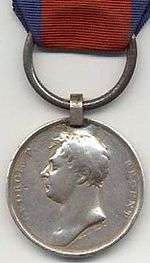Waterloo Medal
| Waterloo Medal | |
|---|---|
|
Obverse (top left) and reverse (top right) of the medal. Ribbon: crimson with dark blue edges each approx. 7 mm wide. | |
| Awarded by United Kingdom of Great Britain and Ireland | |
| Type | Campaign medal |
| Eligibility | British Army. |
| Awarded for | Campaign service. |
| Campaign | Battle of Ligny (16 June 1815), Battle of Quatre Bras (16 June 1815), Waterloo, (18 June 1815). |
| Description | Silver disk 37 mm wide |
| Clasps | None |
| Statistics | |
| Established | 1815 |
It was announced in the London Gazette [1]on 23rd April 1816 that in a Memorandum from Horse Guards on 10th March 1816 by the Prince Regent that The Waterloo Medal was conferred upon every Officer, Non-Commissioned Officer and Soldier of the British Army (including members of the King's German Legion) who took part in one or more of the following battles: Battle of Ligny (16 June 1815), Battle of Quatre Bras (16 June 1815), and the Battle of Waterloo (18 June 1815).[2][3][lower-alpha 1]
The medal was issued in 1816–17 to every soldier present at one or more of these battles. They were also credited with two years extra service and pay, to count for all purposes.[4] The soldier was known and described as a 'Waterloo Man'. The obverse of this medal bears the effigy of the Prince Regent with the inscription 'GEORGE P. REGENT', while the reverse depicts the seated figure of Victory with the words 'WELLINGTON' and 'WATERLOO' below and the date 'JUNE 18 1815'. The ribbon passes through a large iron ring on top of the medal. The medal is made of silver and is 37mm wide. A total of 39,000 were awarded.[2]
This is the first medal issued by the British Government to all soldiers present at an action. The Military General Service Medal (MGSM) commemorates earlier battles, but was not issued until 1848. The Waterloo Medal was also the first campaign medal awarded to the next-of-kin of men killed in action. It was designed by Thomas Wyon after a design competition.
At the time the granting of this medal, it was anything but popular in the British Army, the veterans of the Peninsula War feeling aggrieved that those who were present at Waterloo—many of them raw recruits, who had never seen a shot fired before—should receive such a public acknowledgement of their achievements; while they, who had undergone the labours and privations of the whole war, had had no recognition of their services beyond the thirteen votes of thanks awarded to them in Parliament. There was no doubt some truth in what was averred by and on the part of the old soldiers; at the same time it must be remembered, that British military pride had hitherto rebelled against the practice common in Continental armies, of conferring medals and distinctions on every man, or every regiment, who had simply done their duty in their respective services.[5]
It was also the first medal on which the recipient's name was impressed around the edge by machine.[4]
Other Waterloo medals
Five other nations of the Seventh Coalition also struck medals for soldiers who took part in the campaign:[6]
- This medal for British and King's German Legion troops
- Brunswick Waterloo Medal
- Hanoverian Waterloo Medal
- Nassau Waterloo Medal
- Prussian Waterloo Medal
Notes
- ↑ Those stationed with in reserve under Sir Charles Colville at Hal were also entitled to the medal if they were members of the following regiments, or portions of regiments: 35th Foot, 2nd Battalion; 54th Foot, 1st Battalion; 59th Foot, 2nd Battalion; 91st Foot, 1st Battalion. These regiments were not, however, allowed to assume the word "waterloo" on their colours, as appears by a War-Office Order, dated 23 December, 1815.[7]
- ↑ London Gazette, 23rd April 1816, Number 17130, Page 749
- 1 2 Raugh 2004, p. .
- ↑ NMP staff 2014.
- 1 2 Gordon 1979, p.
- ↑ Royal Numismatic Society 1869, p. 111.
- ↑ Royal Numismatic Society 1869, p. 109.
- ↑ Royal Numismatic Society 1869, p. 110.
References
- Gordon, Major Lawrence L. (1979). Joslin, Edward C, ed. British Battles and Medals (5th ed.). London: Spinks & Son. ISBN 978-0-907605-25-6.
- NMP staff (2014). "review of Waterloo Medal Roll". Naval & Military Press. Retrieved March 2014. Check date values in:
|access-date=(help) - Raugh, Harold E. (2004). The Victorians at War, 1815–1914: An Encyclopedia of British Military History. ABC-CLIO. ISBN 978-1-57607-925-6.
- Attribution
 This article incorporates text from a work in the public domain: Royal Numismatic Society (1869). "On English and Foreign Waterloo Medals". The Numismatic Chronicle. 9. Royal Numismatic Society (Great Britain).
This article incorporates text from a work in the public domain: Royal Numismatic Society (1869). "On English and Foreign Waterloo Medals". The Numismatic Chronicle. 9. Royal Numismatic Society (Great Britain).

